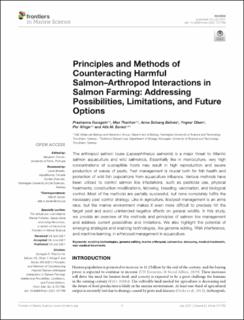| dc.contributor.author | Guragain, Prashanna | |
| dc.contributor.author | Tkachov, Max | |
| dc.contributor.author | Båtnes, Anna Solvang | |
| dc.contributor.author | Olsen, Yngvar | |
| dc.contributor.author | Winge, Per | |
| dc.contributor.author | Bones, Atle M. | |
| dc.date.accessioned | 2021-07-28T11:55:30Z | |
| dc.date.available | 2021-07-28T11:55:30Z | |
| dc.date.created | 2021-07-25T13:13:10Z | |
| dc.date.issued | 2021 | |
| dc.identifier.citation | Frontiers in Marine Science. 2021, 8, . | en_US |
| dc.identifier.issn | 2296-7745 | |
| dc.identifier.uri | https://hdl.handle.net/11250/2765530 | |
| dc.description.abstract | The arthropod salmon louse (Lepeophtheirus salmonis) is a major threat to Atlantic salmon aquaculture and wild salmonids. Essentially like in monoculture, very high concentrations of susceptible hosts may result in high reproduction and severe production of waves of pests. Pest management is crucial both for fish health and protection of wild fish populations from aquaculture influence. Various methods have been utilized to control salmon lice infestations, such as pesticide use, physical treatments, construction modifications, fallowing, breeding, vaccination, and biological control. Most of the methods are partially successful, but none completely fulfills the necessary pest control strategy. Like in agriculture, lice/pest management is an arms race, but the marine environment makes it even more difficult to precisely hit the target pest and avoid unintended negative effects on general wildlife. In this study, we provide an overview of the methods and principles of salmon lice management and address current possibilities and limitations. We also highlight the potential of emerging strategies and enabling technologies, like genome editing, RNA interference, and machine learning, in arthropod management in aquaculture. | en_US |
| dc.language.iso | eng | en_US |
| dc.publisher | Frontiers Media | en_US |
| dc.rights | Navngivelse 4.0 Internasjonal | * |
| dc.rights.uri | http://creativecommons.org/licenses/by/4.0/deed.no | * |
| dc.title | Principles and Methods of Counteracting Harmful Salmon–Arthropod Interactions in Salmon Farming: Addressing Possibilities, Limitations, and Future Options | en_US |
| dc.type | Peer reviewed | en_US |
| dc.type | Journal article | en_US |
| dc.description.version | publishedVersion | en_US |
| dc.source.volume | 8 | en_US |
| dc.source.journal | Frontiers in Marine Science | en_US |
| dc.identifier.doi | https://doi.org/10.3389/fmars.2021.701793 | |
| dc.identifier.cristin | 1922560 | |
| dc.description.localcode | Copyright © 2021 Guragain, Tkachov, Båtnes, Olsen, Winge and Bones. This is an open-access article distributed under the terms of the Creative Commons Attribution License (CC BY). The use, distribution or reproduction in other forums is permitted, provided the original author(s) and the copyright owner(s) are credited and that the original publication in this journal is cited, in accordance with accepted academic practice. No use, distribution or reproduction is permitted which does not comply with these terms. | en_US |
| dc.source.articlenumber | 701793. | en_US |
| cristin.ispublished | true | |
| cristin.fulltext | original | |
| cristin.qualitycode | 1 | |

